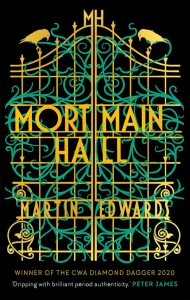Martin Edwards is my guest
 I’m delighted to welcome to my blog, my good friend Martin Edwards. Congratulations are in order as he is this year’s winner of the prestigious CWA Diamond Dagger for contributions to crime fiction.
I’m delighted to welcome to my blog, my good friend Martin Edwards. Congratulations are in order as he is this year’s winner of the prestigious CWA Diamond Dagger for contributions to crime fiction.
His new novel, Mortmain, set between the wars, is just out. It is the follow-up to the splendid Gallows Court. It is on my TBR pile and I am looking forward to discovering what his glamorous heroine, Rachel Savernake, will get up to next. It opens with her boarding a funeral train on the London Necroplis Railway . . .
I asked Martin about the challenges and pleasure of writing historical crime fiction. This is what he had to say.
Writing the 1930s Today
Most of my fiction is set in the here and now, but I’m fascinated by history and over the years I’ve written quite a few mysteries set at different times in the past. These include numerous short stories and also a novel about the life and misadventures of Dr Crippen, Dancing for the Hangman; I loved writing that one because it gave me the chance to get inside the head of a strange and fascinating character.
During the past few years, I’ve indulged my lifelong love of Golden Age detective fiction in factual work such as The Golden Age of Murder and introductions to the British Library Crime Classics. I found myself increasingly drawn to the Twenties and Thirties, and this prompted me to try writing a novel set in 1930.
This book was Gallows Court; it represented a major departure from my previous novels, partly because I didn’t plan the storyline in advance, and partly because creating the lead character, Rachel Savernake, gave me the chance to write from a fresh perspective that I found exciting. Of course, even a historical novel reflects the attitudes of the period when it was written – so I aimed to embrace that reality, whilst trying to remain faithful to the conventions of the time when the action takes place.
Rachel and the journalist Jacob Flint return in my latest book. Mortmain Hall has an elaborate whodunit plot in the classic tradition, and I’ve revived the notion of the Cluefinder, setting out the clues to the mystery at the end of the story. Of course, one of the differences between this book and the novels written during the Golden Age is that I wasn’t alive in 1930, so research is vital.
Having soaked myself in vintage popular fiction, I had an advantage in terms of understanding the period, but I still found it necessary to research extensively. This takes time, but when it yields results, it can be infinitely rewarding. And one of the first reactions to Mortmain Hall – totally unexpected – was a post on the Desperate Reader blog (https://desperatereader.blogspot.com/2020/04/booze-and-books-mortmain-hall-post.html) discussing, of all things the various types of alcohol that feature in the book. Not only did I enjoy the piece enormously, I was also very glad that I’d taken the trouble to do my homework! Nobody can get it right all the time, but when writing a historical crime novel, one owes it to one’s readers to try to give the story a whiff of authenticity as well as serving up an entertaining mystery.
To find out more about Martin, do go to his splendid blog, one of my must-reads: DoYouWriteUnderYourOwnName.blogspot
6 Comments
Margot Kinberg
April 16, 2020Fascinating! Thanks, both, and congratulations, Martin!
Christine Poulson
April 16, 2020Thanks, Margot!
tracybham
April 16, 2020Very nice post, and I especially enjoyed the part about the authenticity of the alcohol served in the book. Mortmain Hall has not been released in the US yet but I have recently purchased a copy of Gallows Court and look forward to reading it soon.
Christine Poulson
April 17, 2020Yes, I enjoyed that, too! I feel sure you will enjoy Gallows Court.
Moira@Clothes in Books
May 17, 2020How nice to find two of my good crimewriter friends in one place! I too am very much looking forward to reading Martin’s new one.
Christine Poulson
May 17, 2020Me, too. Have not yet started.